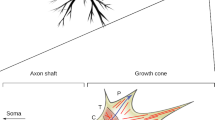Abstract
THE identity and patterning of ventral cell types in the vertebrate central nervous system depends on cell interactions1. For example, induction of a specialized population of ventral midline cells, the floor plate, appears to require contact-mediated signalling by the underlying notochord, whereas diffusible signals from the noto-chord and floor plate can induce ventrolaterally positioned motor neurons. Sonic hedgehog (Shh), a vertebrate hedgehog-family member, is processed to generate two peptides (Mr 19K and 26/27K) which are secreted by both of these organizing centres2,30. Moreover, experiments in a variety of vertebrate embryos3-5, and in neural explants in vitro5, indicate that Shh can mediate floor-plate induction. Here we have applied recombinant Shh peptides to neural explants in serum-free conditions. High concentrations of Shh bound to a matrix induce floor plate and motor neurons, and addition of Shh to the medium leads to dose-dependent induction of motor neurons. All inducing activity resides in a highly conserved amino-terminal peptide (Mr 19K). Moreover, antibodies that specifically recognize this peptide block induction of motor neurons by the notochord. We propose that Shh acts as a morphogen to induce distinct ventral cell types in the vertebrate central nervous system.
Similar content being viewed by others
References
Smith, J. C. Curr. Biol. 3, 582–585 (1993).
Bumcrot, D. A., Takada, R. & McMahon, A. P. Molec. cell. Biol. 15, 2294–2303 (1995).
Echelard, Y. et al. Cell 75, 1417–1430 (1993).
Krauss, S., Concordet, J.-P. & Ingham, P. W. Cell 75, 1431–1444 (1993).
Roelink, H. et al. Cell 76, 761–775 (1994).
Fietz, M. J. et al. Development (Suppl.) 120, 43–51 (1994).
Mohler, J. Genetics 120, 1061–1072 (1988).
Lee, J. L., von Kessler, D. P., Parks, S. & Beachy, P. Cell 71, 33–50 (1992).
Ingham, P. W. Nature 366, 560–562 (1993).
Heberlein, U., Wolff, T. & Rubin, G. M. Cell 75, 913–926 (1993).
Ma, C., Zhou, Y., Beachy, P. A. & Moses, K. Cell 75, 927–938 (1993).
Tabata, T. & Kornberg, T. B. Cell 76, 89–102 (1994).
Heemskerk, J. & DiNardo, S. Cell 76, 449–460 (1994).
Basler, K. & Struhl, G. Nature 368, 208–214 (1994).
Díaz-Benjumea, F. J., Cohen, B. & Cohen, S. M. Nature 372, 175–179 (1994).
Lee, J. J. et al. Science 266, 1528–1537 (1994).
Ingham, P. W. & Fietz, M. J. Curr. Biol. 5(4), 432–441 (1995).
Riddle, R. D., Johnson, R. L., Laufer, E. & Tabin, C. Cell 75, 1401–1416 (1993).
Chang, D. T. et al. Development 120, 3339–3353 (1994).
Porter, J. A. et al. Nature 374, 363–366 (1995).
Hamburger, V. & Hamilton, H. L. J. Morph. 88, 49–92 (1951).
Tsuchida, T. et al. Cell 79, 957–970 (1995).
Tanaka, H. & Obata, K. Devl Biol. 106, 26–37 (1984).
Yamada, T., Placzek, M., Tanaka, H., Dodd, J. & Jessell, T. M. Cell 64, 635–647 (1991).
Thor, S., Ericson, J., Brännström, T. & Edlund, T. Neuron 7, 881–889 (1991).
Yamada, T., Pfaff, S. L., Edlund, T. & Jessell, T. M. Cell 73, 673–686 (1993).
Fietz, M. J., Jacinto, A., Taylor, A. M., Alexandre, C. & Ingham, P. W. Curr. Biol. (in the press).
Hynes, M., Poulsen, K., Tessier-Lavigne, M. & Rosenthal, A. Cell 80, 95–101 (1995).
Dubendorff, J. W. & Studier, F. W. J. molec. Biol. 219, 45–59 (1991).
Marti, E., Takada, R., Bumcrot, D. A., Sasaki, H. & McMahon, A. P. Development (in the press).
Author information
Authors and Affiliations
Rights and permissions
About this article
Cite this article
Marti, E., Bumcrot, D., Takada, R. et al. Requirement of 19K form of Sonic hedgehog for induction of distinct ventral cell types in CNS explants. Nature 375, 322–325 (1995). https://doi.org/10.1038/375322a0
Received:
Accepted:
Issue Date:
DOI: https://doi.org/10.1038/375322a0
- Springer Nature Limited
This article is cited by
-
Transcriptome profiles of sturgeon lateral line electroreceptor and mechanoreceptor during regeneration
BMC Genomics (2020)
-
Sonic Hedgehog Regulation of the Neural Precursor Cell Fate During Chicken Optic Tectum Development
Journal of Molecular Neuroscience (2018)
-
Shh-mediated centrosomal recruitment of PKA promotes symmetric proliferative neuroepithelial cell division
Nature Cell Biology (2017)
-
Efficient derivation of dopaminergic neurons from SOX1− floor plate cells under defined culture conditions
Journal of Biomedical Science (2016)
-
Notochord manipulation does not impact oesophageal and tracheal formation from isolated foregut in 3D explant culture
Pediatric Surgery International (2016)





